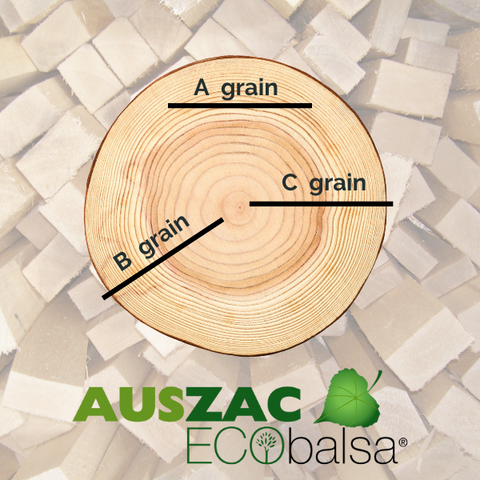cuts from the round log to give us A, B and C grain.
subsequently, the end product or market it goes into.
GRADES ARE EASY
(The Visual Quality)
All our Balsa wood comes from our own plantations or
ones that we manage in Papua New Guinea with our
sister company Auszac Balsa PNG Ltd.
Balsa wood is from the Balsa wood tree, therefore,
mother nature controls what we get in the way of visual
quality, however, we can increase our quality and yield
by best plantation management and processes but in
general PNG grown Balsa is best.
A
So after felling the tree, the time from the tree to a flitch and
then, the kiln drier plays a significant role in
maximising the amount of A-grade quality that you'll find
available at Balsacentral, Clean, white and blemish-free.
PNG Balsa is generally a cleaner-looking balsa wood; we
don't use chemicals like bleach to achieve this, just the best
practice. Sometimes this grade is referred to as AAA or
Premium
B
The lesser B-grade is usually destined for the markets
where appearance is not so critical and slight
discolouration or small knots do not concern the
consumer or sometimes even enhance their project.
C
For the consumer, C-grade balsa wood will never make it
to market, well, not ours unless specifically required. Lots
of natural staining, marks and knots in this grade and
most of it ends up fuelling our Kiln driers to dry the good
stuff so it's going to good use anyway

NOW FOR THE GRAIN
(The cut orientation)
Like all natural timber, the way the square or rectangular
piece is cut from a round log determines the grain
orientation and ultimately the mechanical properties of the
finished item.
Much can be said about A, B, and C grain and where to use
it etc. But the following is a simple explanation for now.
A
Most of what you see on the market is A- grain Balsa wood. Agrain
balsa is cut at a 90-degree angle to the rays and has a
much softer, flexible texture. This makes it a great choice for
items that need to be more malleable and pliable.
B
The B-grain is cut from the log on a 45-degree angle offset to
the centre pith. Identified with longer visual grain lines.
Effectively a mix of A and C grains and therefore has a mix of
the mechanical properties of A and C in lessor amounts.
C
C-grain balsa is also known as quarter-sawn balsa and has very
distinct lines that run radially outwards from the centre (pith) of
the tree. This type of grain pattern is more resistant to flexing
than other grain versions, making it ideal for items that require
more rigid support.
This grain is easily identified in sheet form as it appears to have
shimmery patterns.
As the recovery from the Balsa tree to a finished
piece is very low due to several reasons, to cut the log
specifically to find the grain would be ridiculously
uneconomical and therefore logs are broken down
into square and rectangle sections for pure maximum
recovery.
The fact that we can offer A, B or C-grain is purely
luck of the draw situation, sometimes we have lots
and sometimes we don't but at least we turn over lots
of Balsa wood and have more choices.
On your next order put your requests into the notes
section of the cart. Or call us on 08 8276 4482
sales@balsacentral.com.au


